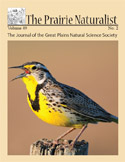Great Plains Natural Science Society

The Prairie Naturalist
Date of this Version
12-2011
Document Type
Article
Citation
The Prairie Naturalist 43(3/4):117–118. December 2011
Abstract
The northern harrier (Circus cyaneus) is a widespread raptor commonly found nesting throughout the Northern Great Plains. Northern harriers forage primarily on small mammals and passerines with the males providing the majority of prey to nestlings until 14–28 days of age (Redpath et al. 2006, Vukovich and Ritchison 2006). Although the genus Circus is known to predate eggs from nest of many nesting birds (Hiraldo et al. 1975, Donaszar et al. 1996, Opermanis et al. 2000), few have been recorded commandeering nests of different species (Laine 1928, Fleskes 1992). In June 2010, we observed a northern harrier that began sitting on an active mallard (Anas platyrhynchos) nest, hatched mallard ducklings, and then continued to incubate until her eggs hatched.
We located and monitored numerous nesting grassland bird species on our research plots including: sharp-tailed grouse (Tympanuchus phasianellus), ring-necked pheasant (Phasianus colchicus), mallard, gadwall (A. strepera), northern shoveler (A. clypeata), blue-winged teal (A. discors), northern pintail (A. acuta), American widgeon (A. americana), short-eared owl (Asio flammeus), and northern harrier as part of an ongoing project from 2006 to 2010. A primary objective of the study was to determine the effects of sustainable livestock systems on ring-necked pheasant and duck production on post-contract Conservation Reserve Program (CRP) lands in southwestern North Dakota (Geaumont et al. 2010). Our two research plots were located in Adams County, 5 km apart near the town of Hettinger, North Dakota.
Included in
Biodiversity Commons, Botany Commons, Ecology and Evolutionary Biology Commons, Natural Resources and Conservation Commons, Systems Biology Commons, Weed Science Commons


Comments
Published by the Great Plains Natural Science Society, 2011. Used by permission.